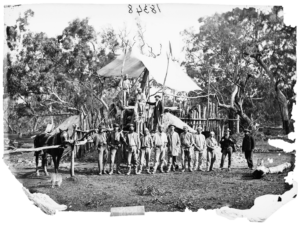Our History

Image: Men and women in front of Sportmans Arms Hotel, next to Barnes Mudgee Store and Plunkett and Co. auctioneers, Mayne Street, Gulgong, New South Wales, ca. 1872
Located at 104-106 Mayne Street Gulgong, The Commercial Travellers House is steeped in history.
From the very beginning in 1870, The Commercial Travellers House, formerly known as The Sportsman’s Arms and then Powells Commercial Hotel (or to locals, “Widow Powells”), gained respect as the leading pub in town and the place where weary commercial travellers would rest their heads after a day trading their wares onsite in the numerous wooden sample rooms.
In 1912, the original old building was replaced by the existing 2 storey brick building and the beautiful iron laced balcony that continues to welcome and impress visitors.
Leading politicians of the day used the premises and prominent verandah as a platform for public speaking to gain public support and spruik their worth. And throughout the buildings lengthy history there is many a link to a local story or myth and even connections to a bushranger by the name of “Midnight” who rustled a local horse – if only the walls could talk.
Stay & Explore
Gulgong has a great deal to offer modern day explorers and travellers and much of it is within walking distance from The Commercial Travellers House accommodation.
Come and visit Gulgong, stay at our historical travellers’ accommodation, and experience everything our beautiful town has to offer.
Gulgong History
Prior to European settlement the region was occupied by the Wiradjuri Aboriginal people. A number of historical and traditional sites have and are being developed across the Mudgee region for those keen to learn more about local aboriginal history, including The Drip, Hands on Rock and Dunns Swamp.
The Gulgong’s history is abundant and varied, with links to Henry Lawson and other famous authors, beautiful historical churches and well-maintained buildings that celebrate the yesteryears and many hours can be spent exploring the streets, museums, and local historical sites.
1872
By 1872 were reputedly 20 000 people in the area. Approximately 15,000 kg of gold was removed from the Gulgong fields between 1870 and 1880.
Image: Men and women in front of Sportmans Arms Hotel, next to Barnes Mudgee Store and Plunkett and Co. auctioneers, Mayne Street, Gulgong, New South Wales, ca. 1872



